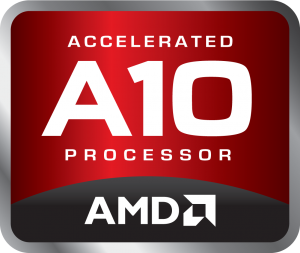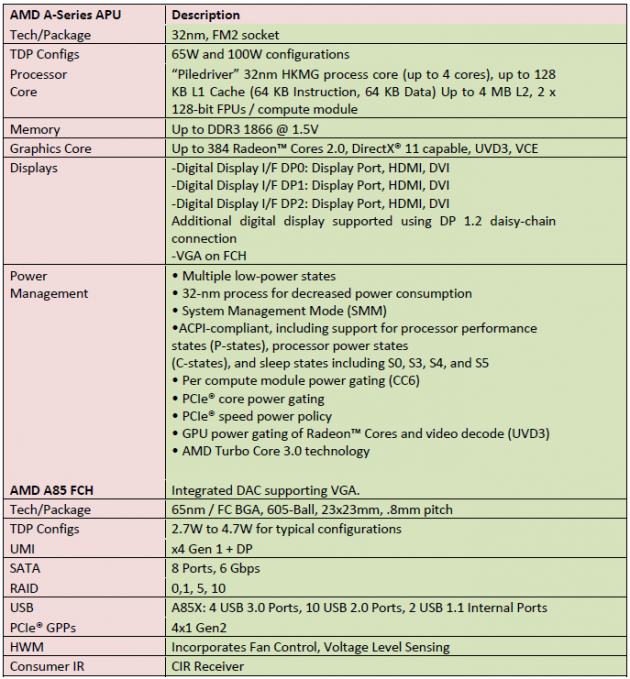 While the embargo for full reviews of AMD’s new A10-5800K APU are set to release soon, we can tell you a few things about the new desktop APU platform tonight.
While the embargo for full reviews of AMD’s new A10-5800K APU are set to release soon, we can tell you a few things about the new desktop APU platform tonight.
For those who aren’t familiar with what an APU (Accelerated Processing Unit), it can best be described as silicon that is designed to accelerate processes beyond traditional CPU roles. We’re at a point in the software world that mainstream applications can take advantage of processor capabilities beyond CPUs, and so APUs are becoming increasingly useful. From a marketing standpoint, the AMD APU can most easily be described as a fusion of GPU and CPU on a single chip. The new A10 5800K, for example, pairs a four-core Piledriver CPU with a 384-shader, 800mhz Radeon 7660D GPU on the same die.
The 2012 lineup of APUs formerly known as Trinity, now known as Virgo, is the first to have unlocked models and Turbo Core 3 support. This family of APUs is the final realization of AMD’s 2006 acquisition of ATI, and we’re finally at a point when a mainstream enthusiast will want to look hard at the A10 APU as a viable alternative to the stigmatized Bulldozer.
The biggest change from the previous generation of APUs is the new Piledriver core. First off, we have support for the latest ISA instructions: FMA4/3, AVX, AES, and XOP. There are also technologies that Bulldozer was sorely lacking in: branch prediction and cache enhancements that should compensate for some of Bulldozer’s well-known problems. Turbo Core support is also there, meaning that if there’s enough room in the TDP envelope, the system will overclock on the fly, up to 4.2GHz.
Full specifications
Product lineup
The SKUs for this 2012 lineup are as follows:
- A10-5800K: Radeon HD 7660D, 100W TDP, 384 shader cores, 800mhz GPU, 4 core CPU, 3.8GHz base/4.2GHz Turbo, 4mb L2 cache, DDR3 1866, Unlocked
- A10-5700: Radeon HD 7660D, 65W TDP, 384 shader cores, 760mhz GPU, 4 core CPU, 3.4GHz base/4.0GHz Turbo, 4mb L2 cache, DDR3 1866
- A8-5600K: Radeon HD 7560D, 100W TDP, 256 shader cores, 760mhz GPU, 4 core CPU, 3.6GHz base/3.9GHz Turbo, 4mb L2 cache, DDR3 1866, Unlocked
- A8-5500: Radeon HD 7560D, 65W TDP, 256 shader cores, 760mhz GPU, 4 core CPU, 3.2GHz base/3.7GHz Turbo, 4mb L2 cache, DDR3 1866
- A6-5400K: Radeon HD 7540D, 65W TDP, 192 shader cores, 760mhz GPU, 2 core CPU, 3.6GHz base/3.8GHz Turbo, 1mb L2 cache, DDR3 1866, Unlocked
- A4-5300: Radeon HD 7480D, 65W TDP, 128 shader cores, 724mhz GPU, 2 core CPU, 3.48GHz base/3.62GHz Turbo, 1mb L2 cache, DDR3 1600
What we will be reviewing is the A10-5800K.
It’s a Kerfluffle!
AMD released a lot of info for this new product launch, but asked review sites to post only some of the info tonight (specifically gaming benchmarks), while waiting until the full embargo date to unveil the full-fledged reviews. The Tech Report’s Scott Wasson took exception to this new experiment in the PR/press relationship and wrote a lengthy blog post about why he thinks this is toeing an ethical line. I personally don’t see it as an ethical violation and I don’t necessarily agree that AMD is attempting to “shape” review content. It’s basically a two-phase review embargo. They want to talk about the most positive and compelling aspects of the new product line first. I’m not sure I see the big deal. I do agree that it’s annoying at best and frustrating for reviewers at worst, but unethical? Hardly. It’s every site’s prerogative and choice of what to publish before embargo date.
At any rate, gaming benchmarks (especially when paired up with another AMD Radeon in dual-graphics mode) are refreshing when you take TDP and cost into consideration. Let’s be frank: AMD is not going to be competing with Intel on the high end, but this new series of products is fascinating and is going to help AMD stay relevant in a very competitive marketplace. The question is, as always, will they remain relevant long enough to buy time to come out with a truly high-end mainstream enthusiast CPU once again?
Our full review is coming soon.














 Articles RSS
Articles RSS